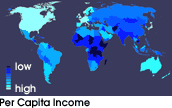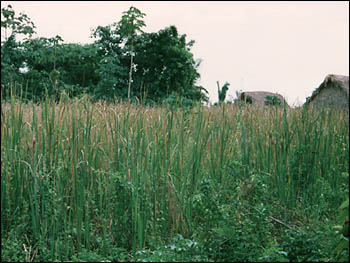| |
"If people weren't poor we wouldn’t have
malaria," said Roberts. One only needs to look at a global map of malaria
outbreaks to get an accurate depiction of where the standard of living is low.
Outbreaks blanket Central Africa, India, Pakistan, and Southeast Asia. In the
Western Hemisphere, a large epidemic exists over the Brazilian rain forest. From
there the disease winds its way up through Central America and into Mexico,
stopping a few hundred miles south of the United States, which was also covered
with the disease not more than sixty years ago. (World Health
Organization, 1998)
The reason malaria infects impoverished areas, Roberts asserted, has little to
do with hygiene, the water supply or a bad diet. Rather, it has to do with the
lack of protection impoverished people have against mosquitoes. The Anopheles
mosquito breeds in standing water, is most active at night and usually bites
people as they rest in their homes. In poorer areas of the world, drainage
systems are usually substandard, so these types of mosquitoes breed in droves.
Once the larvae reach the adult stage, villagers have no way to keep them out of
their houses. Most houses in these areas do not have air conditioners or screens,
and some just consist of a thatched roof and a dirt floor. These people cannot
afford bug repellents or nets. As they eat or sleep, the mosquitoes come and go
as they wish.
"But Malaria is a preventable disease," Roberts said, "The reason it is not
prevented is money, and a commitment on the part of the governments to protect
the people." In the past, people have suppressed malaria by spraying DDT
(dichloro-diphenyl-trichloro-ethane) or other less effective, repellents on
houses. The sprays kill or keep the mosquitoes out of the houses at night when they bite.
However, implementing such a program requires the chemicals
and hundreds of workers to distribute them; and
spraying houses once is not a permanent solution. To really put a
damper on malaria, houses must be sprayed annually, said Roberts. Some
governments are too poor to sustain such a program with no outside help. Other
governments simply do not care. Generally, the more unstable a government is, the
worse malaria epidemics become.
Roberts and his team began their project fifteen years ago to help those
governments with good intentions, but a lack of funds. They based their research
on the idea that vector-borne diseases have definable determinants that can be
mapped. As most diseases spread, they generally follow the economic, political,
racial and even sexual boundaries of our society. Tuberculosis, for instance,
infects areas where people have poor hygiene and medical facilities. Hepatitis C
reaches new victims through blood transfusions, sex and shared needles. Those who
live at the edge of a forest are at no greater risk than those who live near a
swamp or desert. The local terrain and climate make little difference.
Vector diseases, on the other hand, are transmitted by insects and animals,
which live, feed and reproduce in specific environments and have unique ways of
coming into contact with people. While socioeconomic factors can still play a
role, the risk of getting infected ultimately comes down to a person’s
exposure to the disease-carrying creature’s environment. Scientists can map
the risk factors for a vector-borne disease as they would map a flood plain or a
forest.
|
|
 
Poor
nations are affected disproportionately by malaria. People who can not afford air conditioners and
tightly sealed houses are susceptible to mosquito bites, and those who can’t afford expensive
anti-malaria drugs are potential reservoirs of the disease. (Maps from Roll Back Malaria, World Health Organization) |

Using modern technologies such as remote sensing satellites, Roberts’
team planned to identify the environments in which mosquitoes breed and those
homes where occupants are most prone to contracting malaria. "The way we wanted
to use these technologies was like a surgeon’s knife. We wanted to go target
houses according to their risk," he said. With such a system, nations could
then cut the disease off at the source simply by spraying those houses and areas
that have the greatest risk of infection. This strategy could avoid the monetary
and environmental costs of spraying every village in the country.
For the past fifteen years, since the project began, the scientists have
conducted most of their research in Belize with the help of NASA grants and the
full support of the Belizian government. At the center of their research has been
an effort to understand the patterns of past malaria outbreaks. The
Belizeans set up a national malaria database
containing the names and addresses of every reported malaria case in Belize. Roberts’ team
then assisted the government in looking for trends in the database.
They found that the risk of malaria in each house is pretty much constant over
time. Certain houses, due to their location, their construction and a number of
other factors, have a disproportionate number of malaria outbreaks. In fact,
more than fifty percent of malaria cases in most villages occur in less than fifteen
percent of the houses. Knowing this, Roberts’ team developed a system to
categorize these houses in terms of the number of malaria outbreaks they've had.
By spraying these houses alone, Roberts explained, Belize can rid itself of most
of its problem. "If you have a house or an area that is producing a large number
of malaria cases, that house becomes the source of infection for many other
people in the neighborhood," he said.
 Spotting Infection Spotting Infection
 An Unending Epidemic An Unending Epidemic
|
|
The larvae of Anopheles vestitipennis,
a potentially important vector of
malaria, occur in cattail marsh habitats. Houses, like those visible in the background,
are frequently constructed in close proximity to these mosquito habitats. (Photograph courtesy
Dr. Donald Roberts, Uniformed Health Services) |

